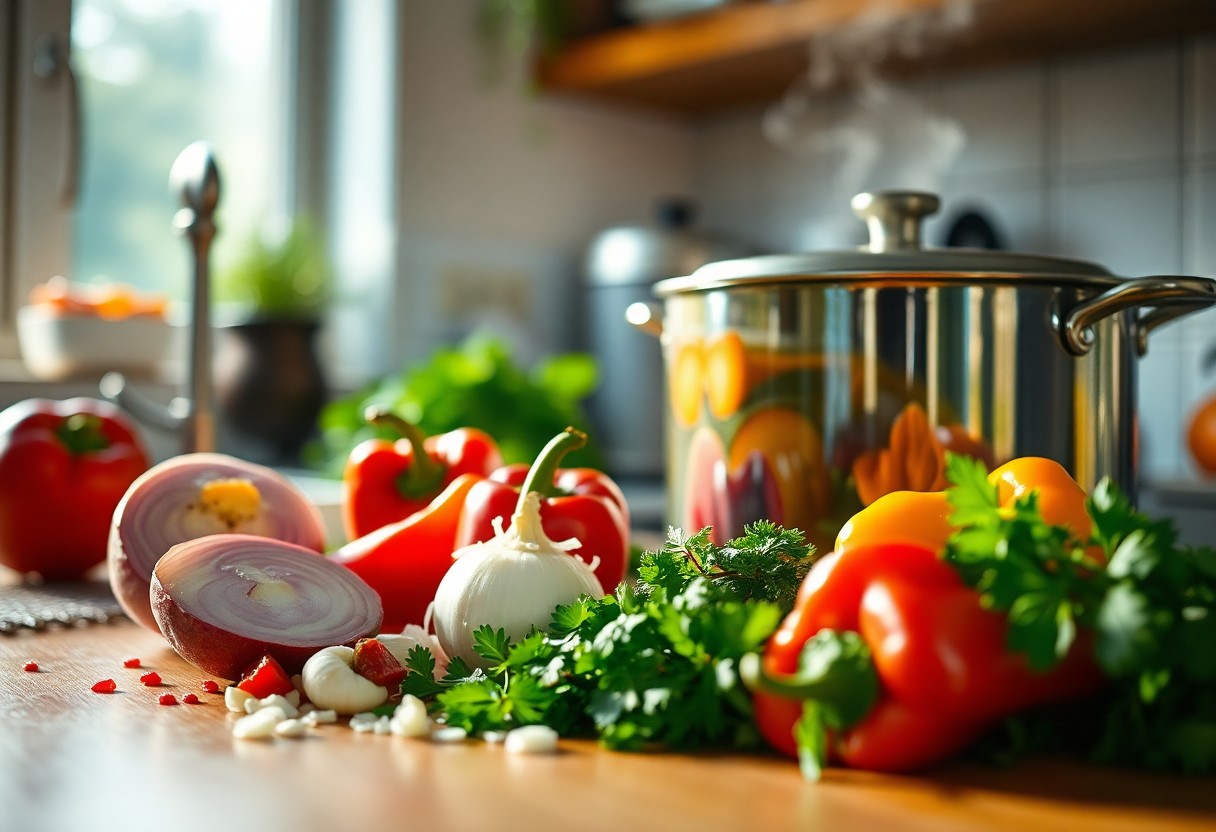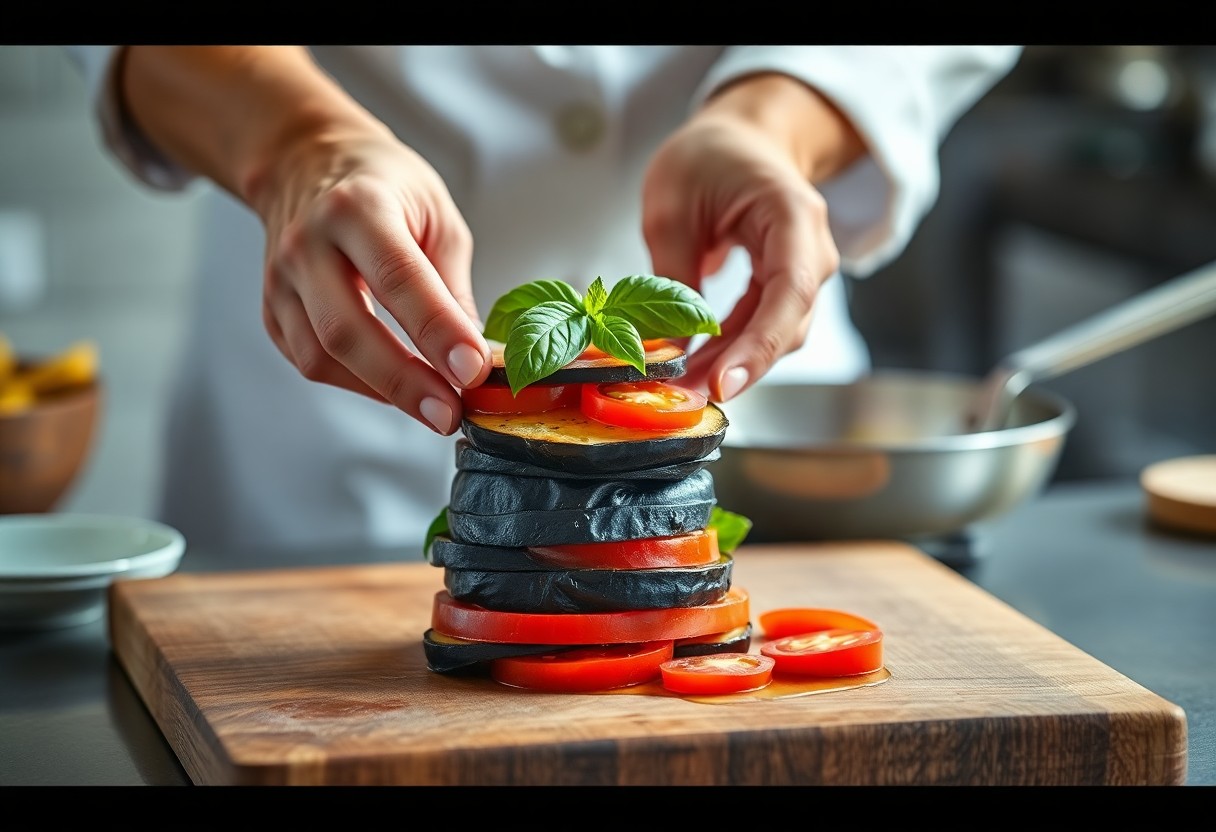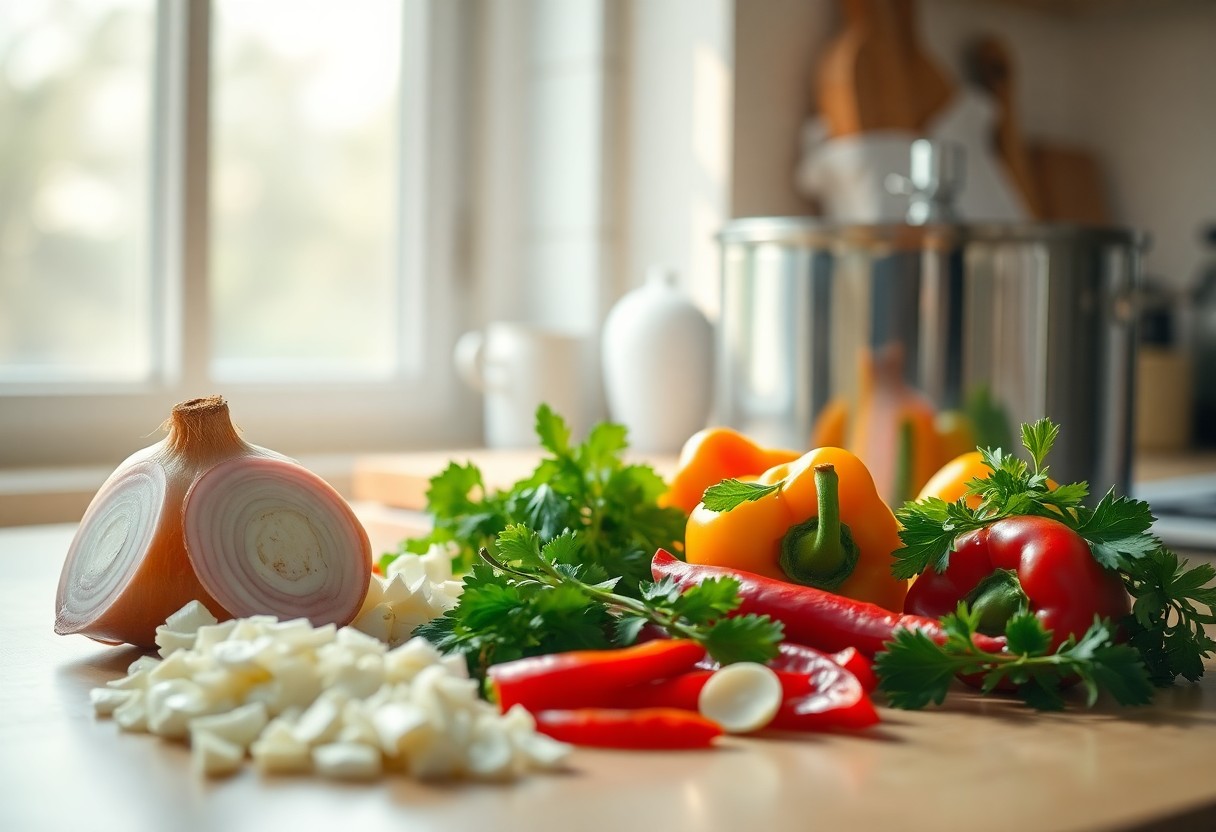There’s a powerful technique that can elevate your dishes and transform your cooking game: building flavor in layers. Instead of relying on a multitude of ingredients, you can enhance the depth and richness of your meals by focusing on the stages of cooking and the natural flavors of your ingredients. In this blog post, you’ll learn how to infuse your dishes with complexity by using smart layering techniques, ensuring your meals are not only delicious but also satisfying without overwhelming your pantry.

Key Takeaways:
- Building flavor in dishes involves strategic layering of ingredients at different cooking stages, enhancing the overall taste without needing additional components.
- Utilizing techniques such as searing, sautéing, and deglazing can effectively concentrate flavors and create depth in a dish.
- Balancing seasoning and adjusting flavors throughout the cooking process helps to ensure a harmonious final result, enhancing the natural characteristics of the main ingredients.

The Art of Layering: Techniques That Elevate Flavor
Mastering the art of layering goes beyond simply adding more ingredients; it’s about understanding how to use what you have in smarter ways. Each layer adds depth, whether it’s from spices, herbs, or varying textures, and plays a vital role in crafting a cohesive flavor experience. By focusing on timing and order, you’ll learn to create harmony in your dishes, yielding something that tastes richer than the sum of its parts.
Building Blocks of Flavor Profiles
To construct complex flavor profiles, you first need to identify your building blocks: salt, acidity, sweetness, bitterness, and umami. Each component carries its own weight and can shift the entire profile of a dish. For instance, a pinch of salt enhances sweetness, while a splash of vinegar brightens up heavy or overly rich flavors. By interplaying these elements during cooking, your dishes can maintain balance and intrigue with fewer ingredients.
The Role of Cooking Techniques in Flavor Development
Certain cooking techniques are game-changers for flavor development. Techniques like searing, braising, and roasting create *Maillard reactions*, which add a depth of flavor through caramelization. Moreover, slow cooking allows ingredients to meld and develop a more profound taste, which can be harvested in soups or stews. Understanding how different methods impact flavor enables you to maximize the potential of each layer you build.
For example, searing meat develops a rich, brown crust due to the Maillard reaction, infusing your dish with savory notes that enhance the overall flavor. Conversely, simmering herbs at low heat releases their important oils gradually, creating a more nuanced taste. By employing these techniques strategically, you can elevate the flavor profile of your dishes without needing to add extra ingredients, ensuring every bite is bursting with complexity.
Mastering The Sauté: A Technical Approach
Perfecting the sauté technique can significantly enhance your cooking by creating layers of flavor through proper heat control and timing. This method allows you to build a rich base in a short amount of time, utilizing the power of high heat to develop complex flavors while retaining the ingredients’ integrity. Focus on achieving that perfect golden-brown surface, as it acts as a flavor foundation for the rest of your dish.
The Maillard Reaction: Unlocking Depth of Flavor
The Maillard reaction is your ally in achieving that deep umami flavor that makes dishes unforgettable. This chemical reaction occurs when proteins and sugars in food react under heat, resulting in complex flavor compounds and browning. You’ll notice this transformation as meats and vegetables turn golden, producing a mouthwatering aroma that indicates flavor is developing beautifully.
Utilizing Aromatics: Onions, Garlic, and Beyond
Aromatics play an vital role in layering flavor, providing a savory backbone to many dishes. Onions, garlic, and herbs release their natural oils and compounds when sautéed, infusing your dish with fragrant depth. You can experiment with various combinations, such as shallots and fresh thyme or leeks and rosemary, to discover new flavor dimensions.
Onions are particularly versatile, offering sweetness that balances well with the acidity of tomatoes or the richness of meats. Start with a base of finely chopped onions, allowing them to soften and caramelize before adding garlic. Garlic, in just the right amount, brings a pungent kick, enhancing your dish’s overall profile. Don’t shy away from incorporating other aromatics like bell peppers, ginger, or celery; each brings its unique flavor nuances that can transform even the simplest sauté into a complex culinary experience.
Seasoning in Stages: Timing is Everything
Timing your seasoning transforms ordinary dishes into exceptional ones. By strategically adding salt, herbs, spices, and acidic ingredients at various stages of cooking, you create a depth of flavor that builds upon each layer. Early seasoning can strengthen the base flavors, while a final touch of salt or acid can brighten and enhance your dish right before serving. This method encourages you to be mindful of how each addition works with the ingredients, maximizing their potential without cluttering the flavor profile.
When to Season for Maximum Impact
Seasoning early in the cooking process allows flavors to meld together, yet applying a pinch of salt towards the end can elevate the dish’s overall taste. When sautéing vegetables, add salt to draw out moisture, enhancing their natural sweetness. For proteins, brining them overnight or applying salt before cooking will profoundly impact their juiciness and flavor. However, a sprinkle of finishing salt on a plated dish provides an immediate flavor burst, creating a harmonious balance that excites the palate.
Balancing Acidity and Sweetness at Every Layer
Acidity and sweetness enhance each other and create a well-rounded dish. You can introduce acidity through ingredients like vinegar, citrus, or tomatoes, while sweetness can come from ingredients like caramelized onions or a drizzle of honey. Layering both elements at different stages watches how they interact—adding citrus juice at the end brightens a dish, while tomatoes simmered long can mellow acidity and enhance sweetness. The balance between these factors in each layer ensures your dish achieves a resonance that tantalizes the taste buds without overwhelming them.
Achieving the perfect balance of acidity and sweetness involves careful consideration of your ingredients and their cooking times. For instance, incorporating a splash of balsamic vinegar while sautéing onions lends complexity and depth to a dish. Yet, adding a hint of sugar at the end can further round out flavors, particularly in tomato-based sauces or dressings. Experimenting with ratios in different stages will allow you to tailor dishes that resonate with your specific palate, creating depth and interest that elevates your cooking without the need for extra ingredients.
Texture as a Flavor Enhancer: Not Just for Crunch
Texture significantly impacts the perception of flavor, providing a multi-dimensional experience even without additional ingredients. For instance, a creamy sauce can enhance the savoriness of a dish while a smooth puree can accentuate the freshness of vegetables. By incorporating various textures, you’ll engage your palate in unexpected ways, elevating the overall dining experience. Consider balancing soft with firm, like pairing flaky fish with a crisp vegetable slaw, to deepen flavor without the need for more spices or ingredients.
The Importance of Contrast in Dishes
Balancing contrasting textures brings your dishes to life. Pairing elements such as creamy risotto with crunchy roasted nuts creates a delightful interplay that excites your taste buds. Each bite becomes an adventure through varying mouthfeel, enhancing the dish’s satisfaction without ever needing additional flavorings. This contrast can highlight the inherent flavors of your main ingredients while keeping your meals interesting and appealing.
Techniques to Add Complexity Without Extra Ingredients
Employ a mix of techniques to enhance flavor complexity without extra ingredients. Methods like searing, braising, or grilling can create depth, while incorporating cooking methods that concentrate flavors—like roasting vegetables until caramelized—can significantly boost taste. Experimenting with temperature can also create texture contrasts, such as introducing chilled garnishes or sauces over warm dishes, achieving a captivating balance of warm and cold in every bite.
For instance, consider roasting tomatoes until they burst their skins, intensifying their sweetness and umami. As they cool, you can blend them into a salsa, where their concentrated flavor meets the refreshing crispness of raw onion and herbs. This method draws out the best in both raw and cooked elements, offering a rich tapestry of flavor and texture for your dishes. The result is a vibrant and engaging meal that tastes infinitely more complex than the sum of its parts.
Common Pitfalls: Avoiding Missteps in Layering
Even the best intentions can lead to flavor disasters if you’re not vigilant while layering. One common issue is the lack of patience; rushing the cooking process means flavors don’t have enough time to develop fully. Additionally, overlooking the balance between the ingredients can result in muddled or confusing tastes. Pay close attention to the timing and methods of adding ingredients, plus the order in which flavors build. Taking the time to master this technique can make all the difference in achieving that rich, layered flavor profile you’ve been aiming for.
Overseasoning: The Thin Line Between Flavor and Overpowering
Finding the right seasoning balance can feel like walking a tightrope. Too much salt or spice can engulf the other flavors in your dish, leading to an unpleasant dining experience. Start with modest amounts, tasting as you go to fine-tune the profile. A dash of citrus or vinegar can brighten and enhance flavors, adding depth without overwhelming your dish. Always approach seasoning with a light touch until you know how each element interacts within your recipe.
Simplifying Complexity: When Less Really is More
Striking a balance between intricate flavors and simplicity often leads to the best results. Overcomplicating a dish with too many components can lead to a confused palate. Instead, focus on one or two primary flavors and let them shine. For instance, a well-seasoned roast chicken paired with just sautéed greens can be far more satisfying than an overly complex sauce. Distilling your dish down to its vital flavors encourages truly appreciating each ingredient. Aim for a clear vision of what you want to showcase and keep the layers purposeful, amplifying rather than overshadowing.
Conclusion
The art of cooking in layers empowers you to elevate your dishes and build robust flavors without relying on excess ingredients. By focusing on the order and technique of adding ingredients, you can unleash a depth of taste that resonates in every bite. As you practice these layering techniques, you’ll notice how your meals become more satisfying and complex. Embrace this method in your culinary adventures, and you’ll find that flavor enhancement is not just about what you add, but how you develop it from the ground up.
FAQ
Q: What does it mean to cook in layers?
A: Cooking in layers refers to the technique of building flavors gradually throughout the cooking process. Instead of adding all ingredients at once, you introduce them step by step, allowing vegetables, spices, and proteins to release their flavors which enhances the overall taste of the dish. This method often results in more complex and satisfying meals.
Q: How do I start layering flavors in my cooking?
A: Begin by selecting a base ingredient, such as aromatics like onions, garlic, or ginger. Sauté these ingredients in oil or butter to develop a flavorful foundation. Then, gradually add other ingredients such as proteins, vegetables, herbs, and spices at timings that suit their cooking times. This approach allows each ingredient to contribute to the dish’s flavor profile without overwhelming the palate.
Q: Can I use this method for any type of cuisine?
A: Yes! The concept of cooking in layers can be applied across various cuisines and dishes, from soups and stews to stir-fries and casseroles. Each culture may have its own traditional layering techniques, but the fundamental idea of building flavor gradually is universal and can enhance any meal.
Q: What are some common mistakes to avoid when layering flavors?
A: One common mistake is adding all ingredients simultaneously, which can lead to a one-dimensional flavor profile. Additionally, not allowing each ingredient enough time to cook before adding the next can prevent the development of deeper flavors. It’s important to balance the timing of ingredient additions and to taste frequently to ensure proper layering.
Q: How can I apply this technique to make healthier meals?
A: Cooking in layers naturally encourages the use of fresh vegetables and lean proteins while minimizing the need for excess fats and salts. By focusing on seasoning and the natural flavors of your ingredients, you can create flavorful dishes that are also nutritious. Utilizing spices and herbs allows you to enhance taste without relying on added sugars or unhealthy fats.
